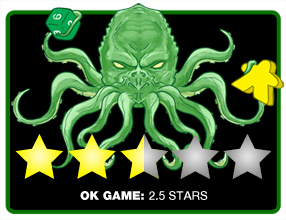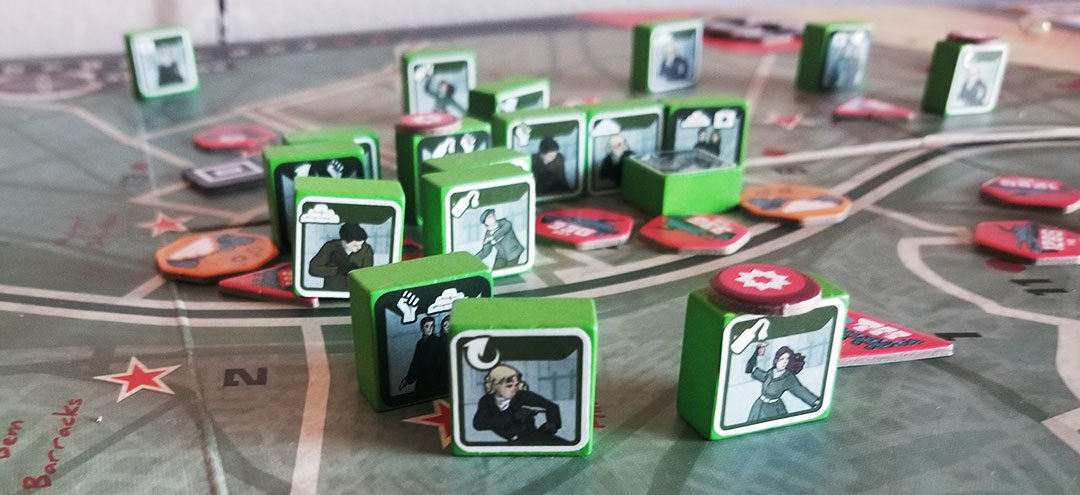 Historical wargames lean in on historical accuracy. Cards in Twilight Struggle are all on events that actually happened and impact the board state in a thematic fashion. Base scenarios in Memoir 44 can be imbalanced to tell the proper story. A key aspect in the second year of Maria is the Imperial Election for the Holy Roman Empire.
Historical wargames lean in on historical accuracy. Cards in Twilight Struggle are all on events that actually happened and impact the board state in a thematic fashion. Base scenarios in Memoir 44 can be imbalanced to tell the proper story. A key aspect in the second year of Maria is the Imperial Election for the Holy Roman Empire.
Nights of Fire: Battle for Budapest continues the trend of wargames that not only tell the story of conflict, but does what it can to tell the tale in an accurate fashion. It offers multiple ways to play, but for both modes, one or two players act as the 1956 Hungarian Revolutionaries. The other player or an AI-controlled opponent plays as the Soviet Army attempting to overtake the capital city. Nights of Fire takes place one week after the first game in the duology, Days of Ire.
Gameplay Overview:
Depending on the mode of play, rounds may look a little different. But in both the competitive and cooperative modes, turns alternate between the Revolutionaries and the Soviets taking actions. The Revolutionary units face the player(s) playing that side, similar to traditional block wargames like Sekigahara or Hammer of the Scots. The tanks and garrisons for the Soviet side are public information but have no stats labeled on the tokens. These instead have an active and disabled side.

The Revolutionaries may discard 1-3 cards to take an action. Cards have numbers and symbols on them that determine what actions are available, and how strong an action is. Basic actions like moving, attacking, or helping civilians flee just use the numbers on cards, and most of them have a certain total necessary to take the action, with some modifiers (ex. The base cost to help civilians flee is six operation points, but is lowered by each block in the same district). Some of the better actions, like counterattacks, ambushes, building barricades, require a played card to have the matching symbol, as well as revealing a hidden block with that same symbol.
Actions for the Soviet side are different from the Revolutionaries, and different in both game modes. If a player is controlling the Red Army, then they will have a deck of 12 cards and selecting six to use for actions and 4-6 to use for a battle deck. One or two cards are played, and all actions are performed in any order. The catch is that all the actions done in that turn must be done in the same divisional sector. These are the thirds that the map is divided into, and Soviet units are labeled with what sector they are in as well.

In the co-op mode, five cards are placed in a row with every other card face up. A die is rolled and the actions listed on the card with the matching result token are carried out entirely. The rules detail which districts are considered the highest threat, which determines the targets of the actions. This mode is named after the historical leader of the Soviets in the conflict, Marshal Ivan Konev.
Play goes on for 10 rounds, or until the Hungarians surrender, either by force or choosing to end the conflict. If the game goes all 10 rounds or if Soviet prestige reaches zero before the surrender, the Revolutionary player(s) win the game. After the surrender, Soviet prestige is adjusted based on the number of blocks remaining on the board and the hidden numbers on the back of the fled civilians. If that number is zero or less, the Hungarians win. If not, the Soviets are victorious.

Game Experience:
I did leave out that in the context of history, the Hungarian Revolutionaries lose in all the endgame outcomes. That is because, as I alluded to in the intro, Nights of Fire seeks to remain historically accurate, and the 1956 Battle of Budapest was a losing battle. No matter who technically wins at the end of the game, the outcome is the same, just at different levels. If 10 rounds are played, or prestige reaches zero before the surrender, the rules state that the Soviet commander is recalled back to Moscow in shame.

Not only do the rules provide these details, but the game feels that way as well. Playing the Hungarians is demoralizing. With each round, at least four Revolutionary units are generally lost by battle. Morale is regularly depleting, and once that reaches zero, it’s game over. The Hungarian’s will always take fewer actions due to how the sides take them. The board begins with tons of green blocks ready to defend their capital. But by Day 2 of the battle, their numbers are nearly halved.
Oh, and Soviet tanks and garrisons are never entirely destroyed when attacked. They are merely disabled, and at the end of a round, they return as an active unit. Plus, when the Revolutionaries do an open attack, their most common form of combat, the Soviets roll a D6 against the readiness track, which is rising and falling based on counterattacks. If the result of a roll is less than the current amount on the track, the unit takes a hit. If it is three less or more, then the unit is automatically killed in battle. It’s always an extreme risk to attempt an open attack, unless readiness is low, continuing to add to the disheartening feel of watching the Hungarians meet their inevitable fate.

It’s also weird to compare this to other wargames. Combat is quite basic, with the Soviet playing flipping a card to determine the number of hits. When the Revolutionary player attacks, their chance of success is 100%, and they may face retaliation if using an open attack. None of the units have statistics, and the Soviet units only have an active or deactivated face. The primary use of the hidden Revolutionary blocks are to keep particular symbols from being public knowledge, particularly the counterattack and ambush symbols. These two are the stronger actions and require both a card and block to have the symbol. Otherwise, compared to block wargame like Sekigahara, the hidden aspect of the blocks serves minimal purpose.
As for components, they are great. The art from Kwanchai Moriya is great, as expected from him, showing the resilience of the Hungarians that stood between Budapest and the Red Army. The board and cards are both thick, and the tokens have a nice feel, shape, and size to them. One minor complaint is the map is made to have districts, and some of the ones closer to the middle are used more frequently, and are quite small compared to some of the lesser-used edge districts.
Final Thoughts:
With each consecutive play, I realized that Nights of Fire: Battle for Budapest is less of a wargame and more of a cooperative-style game with a war theme. Even if someone takes turns as the Soviet player, it’s like they are making the decisions for a co-op game instead of the AI component. Each turn, Soviet forces grow closer and closer to ending the revolution, and instead of fighting back to stop them, the Hungarians work to slow their inevitable victory and shame the commander. Compared to games in the co-op genre, this is more punishing than many others, mainly in the conflict mode, as one assault from a Soviet unit can deal five damage and completely be rid of units that were just recruited.
Variability is also low due to the inevitable outcome seen. Nights of Fire does offer an advanced mode, but even then, it doesn’t make it feel more like a wargame. Nights of Fire has a lot of good ideas on paper, and some aspects I quite enjoy, like blocks and cards both needing symbols to activate some of the better actions. I just don’t know of an instance where I would want to play it when it sits in an odd spot between wargames and cooperative games.
Final Score: 2.5 Stars – Nights of Fire mixes wargame genres and a cooperative game to create an odd mix of mechanics that matches the period, while making some sacrifices for historical accuracy.
 Hits:
Hits:
• Asymmetric sides make turns feel different
• Unique use of blocks
• Solid Co-op AI
• Art and components are high grade compared to wargames
Misses:
• Simplistic combat
• Downhill battle from turn one for Revolutionaries
• Imbalanced sides with only one scenario
• Unsatisfying game end with Soviets always “winning” thematically






















